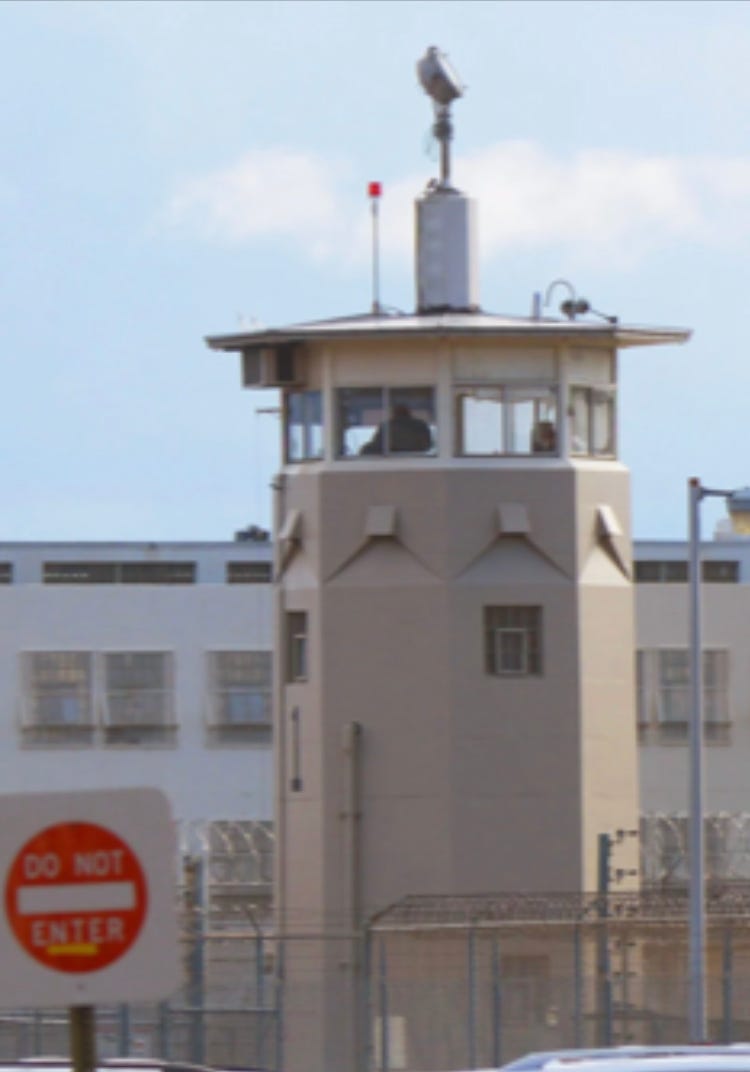Driving down the service road to the prison on Wednesday evenings always cast an eerie spell my way.
The guards in the towers came into view in the darkening sky, shadows behind bulletproof glass. Silver curlicues of barbed wire graced chain link fences. My writing class awaited me in the bowels of the concrete barracks.
I was unsettled every slow drive down that road to class semester after semester by the uninterrupted banging, clanging, screaming, streaming from open cell windows—the night song of the convicts housed at CMF Vacaville.1
Other adjunct faculty from Solano College taught in the prison program. I didn’t know them, never talked with them—we were independent contractors.
I knew one thing: Instructors did not wear blue jeans or anything remotely resembling blue jeans to class. The inmates wore blue jeans.
When the alarm bell sounded on the mainline, which it did from time to time, anyone in blue jeans plastered themselves against the wall to make way for the crush of guards. Civilians, few in number, would be visually discerned and thereby protected by their pants color.
CMF is a maximum security psychiatric prison, and I was the instructor of record for English Comp 101 in the early 1980s. I have to admit I was uncomfortable getting to and from class.
Once in class elements of composition instruction were very different from mainstream practice. For example, inmates usually wrote passionately about one topic: their innocence and the injustice of prison. I learned to make astute comments on punctuation.
My students were atypical CMF inmates in that they had academic experiences well beyond the functionally illiterate bulk of the population.
I had a former priest in class who had executed a young woman with a gun shot to the head. Another man operated a cluster of automobile dealerships on the outside; he was convicted of money-laundering for a Mexican drug cartel.
Students in the class did not look at the clock. They preferred the classroom to all other prison settings. They could take part in discussions inconceivable in the population. The classroom was a privilege.
Steve, a jolly inmate with a creative, artistic streak and a wicked sense of humor, was a sign painter in prison industry. Steve hung around after class to walk out with me and chat.
For the life of me I couldn’t figure out why he was incarcerated. Then it became clear.
“I was in Charlie’s family,” he told me during a chat.
“Oh?” I said.
“I’m pretty much over him,” he said. “You know, he had some magic. He’d call us together in the barn, and he’d start preaching to us and—you’re going to think I’m crazy—the squirrels would stand in the door and listen. Birds would sit on the window sill and sing to him.”
“Oh?” I said.
“I’m in Helter Skelter. Bugliosi writes about me. But he’s wrong. He says I’m mentally retarded. I’m not mentally retarded. I just can’t spell worth beans.”
For two years I taught CMF inmates and gained several insights into composition instruction which I’ll discuss in future posts.
My training in graduate school included work in composition theory; I’d taught a few sections of composition as a graduate assistant at Illinois State.
The heart of what I learned I could not apply in prison.
I remain almost convinced that it’s impossible to teach argumentative writing as public discourse involving logical, ethical, and emotional dimensions to people serving lengthy prison sentences for heinous crimes.
There is a distortion between writer and audience that renders communication challenging.
I’d not seen anything like it again until the recent phenomenon of the Trump supporter.
https://www.cdcr.ca.gov/facility-locator/cmf



